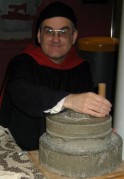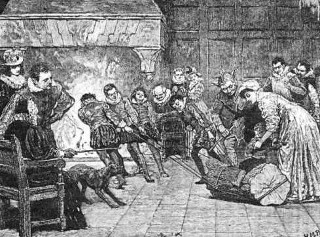Oh, a Christmas Tree
by Graham J. Darling (as Doctor Carus of Burn Abbey); illustration added by Rissa Johnson (as Lady Wymarcha Hektanah “Wendy” Doiron). First published in North Wind, 2013 Dec, n° 354, p 8-9.
Dear Doctor Carus,
Help! There’s a tree sprouting in my hall! I’ve considered fleeing, but baby, it’s cold outside.
Shivering,
Evered Greene
(Doctor Carus replies) My Lord Greene,
Fir not! This is normal for your clime at this time of year.
Such interior decoration is foreshadowed in classical mediterranean mythology (Odysseus had a tree growing in his bedroom), but to understand its later growth through the Middle Ages, you need to know all about the various roles of conifers in the everyday life of northern Europeans (or maybe you don’t, but Doctor Carus will tell you anyway).

As elsewhere, people cut down trees and shaped them into timbers to build houses and barns, or into boards for furniture and ships. More than elsewhere, they also burned wood to keep warm, as well as for cooking and lighting. Hence the tradition of the Yule log, that was ceremonially slowly combusted in defiance of the longest and coldest night of the year, and in reassurance and celebration of the return of longer days. Though widely supposed a pagan holdover [1], its use was first attested only around 1600 [2].
At first, such domestic fires were built on fireproofed hearths in the middle of a room, with a hole in the ceiling to let out the smoke; then from around the 12th C, under canopies or in fireplaces vented by chimneys; then in the 18th C, in ducted metal stoves (surely descended from the athanor of alchemists)[3]. In bonfires banked (partially covered) with earth, wood was also roasted into charcoal, needed to achieve the high temperatures for smelting and forging of metals, especially iron. Channels underneath such kilns would collect any melted and downward-distilled resin as tar (wood tar, that is, not modern petroleum-based asphalt), and run it into containers in nearby pits [4].
As anyone who’s had to handle them knows, softwoods (spruce, fir, pine, cedar) are particularly rich in resin, a sticky water-repellant liquid which generally seals a plant’s wounds and protects it against infection, predation, and dehydration in deserts or dry winters. Resin air-hardens into rosin, that can be anointed or burned for a pleasant smell: frankincense, myrrh and copal are famous examples from other kinds of plants. Under the right conditions, it hardens even further into clear amber (more specifically, yellow ambre jaune, to distinguish from gray ambre gris from sperm whales), that survives the burial and rotting of the tree, to eventually be released to float upon a sea and be cast up on its shore (especially in parts of the Baltic favoured by climate, geology, wind and current), for use as jewelery [5].
Heating tar converts it to pitch, which hardens upon cooling; the distillate from this process is turpentine. Since the time of Noah [6], wooden hulls were caulked with pitch to make them waterproof, then coated with tar to keep them from rotting (so were linen sails, and the shingle roofs of landlubbers); the turpentine dissolved wax for furniture polish, and was medicine against intestinal worms, just as tar treated external cuts and disorders (and was also used in cosmetics and candy)[4]. With all these applications, it’s no wonder that forest products were the major export of medieval Scandinavia; loss of access to these resources contributed to the extinction of the early Norse colonies in Greenland [7].
Back to intact trees indoors. Pagans had long brought in evergreen boughs for winter festive & fertility purpose, as is known from a condemnation by 4th C St Gregory Nazianzen – reversed by 6th C Pope St Gregory the Great (of Gregorian Chant fame, and patron to Dr Carus and other scholars of natural science)[2]. A late and doubtful legend of 8th C St Boniface has him teach German converts to exchange the local oak where they’d performed human sacrifice, for a small home fir and its gentle reminder of life triumphing amidst death [8]. In another, Martin Luther is credited with introducing, in the early 16th century, indoor “Christmas trees” bearing lit candles – which about fits where and when these were first historically attested [9]. Such decorated trees were combined with crèche or Nativity scenes that had been instituted by St Francis of Assisi around 1200 [10], so that the decorated tree would come to represent the sky over Bethlehem (recalling Yggdrasil of the ancient Norse, and a logical metaphor from Nature of a spiritual truth) [12], filled as it was with stars and clouds and birds and angels on that special night 2000 years ago.
From Brother and Doctor Carus, a very merry Christmas to all, and a happy & prosperous New Year!
References:
1. J.G. Frazer The Golden Bough, 3rd Ed, 1922, ch 62, s 7.
2. Ronald Hutton The Stations of the Sun: A History of the Ritual Year in Britain, 1996, ch 4; John Brand “Of the Yule Clog, or Block, Burnt on Christmas Eve”, Popular Antiquities, 1777, rev 1841, vol 1, p 254-257.
3. Dorothy Hartley Lost Country Life, 1979, “December”.
4. T.P. Kaye “Pine Tar – History & Uses”, San Francisco Maritime National Park Association, 1997, http://www.maritime.org/conf/conf-kaye-tar.htm .
5. G.R. Brady & H.S. Clauser Materials Handbook, 13th Ed, 1991, p 631-632, 831-832, 865-867.
6. Genesis 1:6.
7. Jared Diamond Collapse, 2005, p 248-276.
8. M.L. Harvey “How Saint Boniface Kept Christmas Eve”, in The American Normal Readers: Fifth Book, 1912, p 207-222 .
9. J. Lefftz and A. Pfleger, eds., Elsässische Weihnacht, 1941, quoted in R.P. Bucher “O Christmas Tree: The Origin and Meaning of the Christmas Tree”, 2000, http://www.orlutheran.com/html/chrtree.html .
10. St. Bonaventure The Life of St. Francis of Assisi, 1263, ch 10, s7.
11. Snorri Sturluson “Gylfaginning”, in Prose Edda, 13th C .
12. G.K. Chesterton The Everlasting Man, 1925, ch 5.